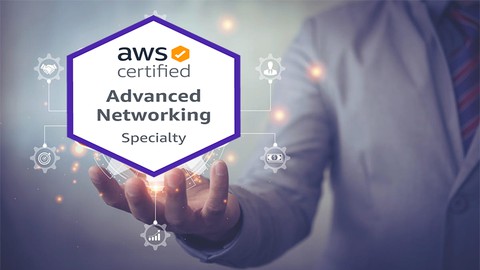AWS Certified Advanced Networking – Specialty Certification

Description
Are you wondering which certification is best in AWS. Then you are at the right place as we present to you the perfect tutorial on how to validate you skills and advance your career with the AWS Certified Advanced Networking – Specialty ( ANS-C00) exam. This exam will open new opportunities and take your career to a next level. Moreover, we provide to you our AWS Certified Advanced Networking – Specialty study guide to pass the exam in your first attempt. But before diving into your preparations, lets understand the exam in detail.
AWS Certified Advanced Networking Specialty exam is designed for candidates who have knowledge and skills to perform complex networking tasks. This exam validates candidates abilities in:
- Designing, developing, and deploying cloud-based solutions using AWS
- Implementing AWS core services with basic architecture best practices
- Maintaining and designing network architecture for all AWS services
- Leveraging tools to automate AWS networking tasks
Prerequisite for the exam
There are a few AWS Certified Advanced Networking – Specialty prerequisites. Candidates applying for the exam need to have knowledge and experience that include:
- Candidates are recommended to hold an AWS Certified Cloud Practitioner or a current Associate-level certification: AWS Certified Solutions Architect – Associate, AWS Certified Developer – Associate or AWS Certified SysOps Administrator – Associate.
- They must have advanced knowledge of AWS networking concepts and technologies.
- Candidates should have a minimum of five years of hands-on experience in architecting and implementing network solutions.
- They should know about advanced networking architectures and interconnectivity options (e.g., IP VPN, MPLS/VPLS) including networking technologies within the OSI model, and how they affect implementation decisions.
- It is recommended to have knowledge of CIDR and subnetting (IPv4 and IPv6) with an understanding of IPv6 transition challenges.
- Candidates must be familiar with the generic solutions for network security features, including WAF, IDS, IPS, DDoS protection, and Economic Denial of Service/Sustainability (EDoS).
- They should know about developing automation scripts and tools that include routing architectures (including static and dynamic), multi-region solutions for a global enterprise, and highly available connectivity solutions (e.g., DX, VPN).
Domain 1: Design and Implement Hybrid IT Network Architectures at Scale
1.1 Implementing connectivity for hybrid IT (AWS Documentation: Hybrid Cloud with AWS, Build a Hybrid Cloud Strategy with AWS)
1.2 Given a scenario for deriving an appropriate hybrid IT architecture connectivity solution (AWS Documentation: Networking Solutions, Hybrid Cloud use cases, connectivity solution)
1.3 Explaining the process to extend connectivity using AWS Direct Connect (AWS Documentation: AWS Direct Connect)
1.4 Evaluating design alternatives that leverage AWS Direct Connect
1.5 Defining routing policies for hybrid IT architectures (AWS Documentation: Internet Routing and Traffic Engineering)
Domain 2: Design and Implement AWS Networks
2.1 Applying AWS networking concepts (AWS Documentation: AWS networking concepts)
2.2 Given customer requirements for defining network architectures on AWS (AWS Documentation: The Journey to Cloud Networking)
2.3 Proposing optimized designs based on the evaluation of an existing implementation (AWS Documentation: The 5 Pillars of the AWS Well-Architected Framework)
2.4 Determining network requirements for a specialized workload (AWS Documentation: AWS Competency Program, How do you configure your networking solution)
2.5 Deriving an appropriate architecture based on customer and application requirements (AWS Documentation: AWS Architecture Center)
2.6 Evaluating and optimizing cost allocations given a network design and application data flow
Domain 3: Automate AWS Tasks
3.1 Evaluating automation alternatives within AWS for network deployments (AWS Documentation: Automate Cloud Governance to Achieve Safety)
3.2 Evaluating tool-based alternatives within AWS for network operations and management (AWS Documentation: Design Principles)
Domain 4: Configure Network Integration with Application Services
4.1 Leveraging the capabilities of Route 53 (AWS Documentation: Amazon Route 53)
4.2 Evaluating DNS solutions in a hybrid IT architecture (AWS Documentation: Hybrid Cloud DNS Options for Amazon VPC)
4.3 Determining the appropriate configuration of DHCP within AWS (AWS Documentation: DHCP options sets)
4.4 Given a scenario for determining an appropriate load balancing strategy within the AWS ecosystem (AWS Documentation: Getting Started with Amazon EC2 Spot Instances)
4.5 Determining a content distribution strategy to optimize for performance (AWS Documentation: Improve your website performance with Amazon CloudFront)
4.6 Reconciling AWS service requirements with network requirements (AWS Documentation: Amazon WorkSpaces Client Network Requirements)
Domain 5: Design and Implement for Security and Compliance
5.1 Evaluating design requirements for alignment with security and compliance objectives (AWS Documentation: Amazon Web Services: Risk and Compliance)
5.2 Evaluating monitoring strategies in support of security and compliance objectives (AWS Documentation: AWS Cloud Security)
5.3 Assessing AWS security features for managing network traffic (AWS Documentation: Amazon Web Services:
Overview of Security Processes)
5.4 Utilizing encryption technologies to secure network communications (AWS Documentation: protect your data in transit)
Domain 6: Manage, Optimize, and Troubleshoot the Network
6.1 Given a scenario for troubleshooting and resolve a network issue (AWS Documentation: Troubleshooting AWS Direct Connect)
Who this course is for:
- All Levels






